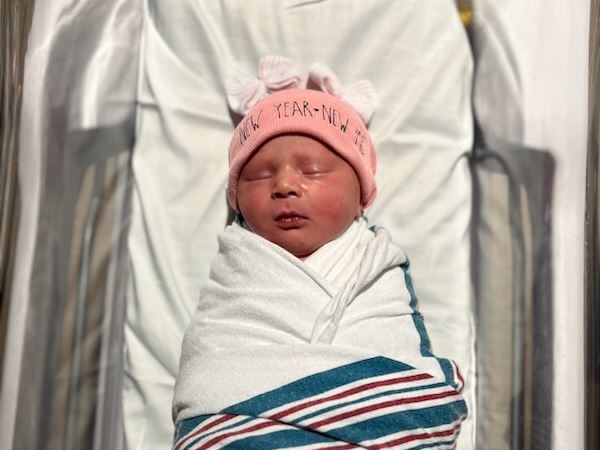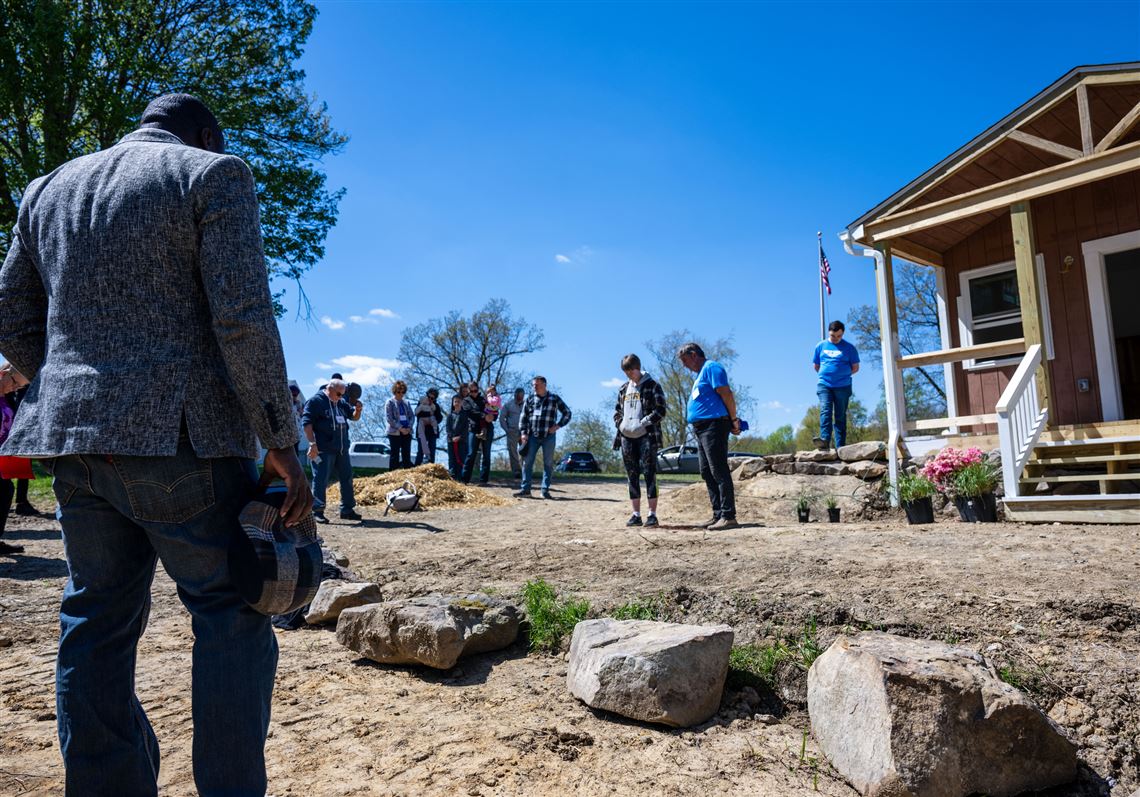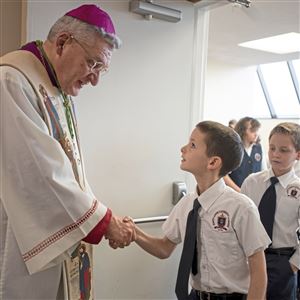PHILIPPI, W.VA — Just beyond the limits of Philippi, a designated “All West Virginia Community” of 2,900 people, is a humble house waiting for its first owner.
First, travel over the nearly two-century-old, double-barreled covered bridge leading into downtown and past winding roads surrounded by Appalachian woods, regaining their green hue post winter. It’s here where Ruston Seaman’s vision begins, in the form of a 500-square-foot, bungalow-style home.
“If you understand what it means to lose your family, you understand chronic homelessness because life's not a straight line for a lot of people,” Mr. Seaman said. “Kids aging out of foster care are struggling.”
To prevent young people in his community from falling through the cracks, Mr. Seaman’s nonprofit, New Vision, is working to build a village of 24 tiny homes — a place where foster youth can reach stability and heal. Members of the public had the chance to see the first, nearly completed home themselves during a ribbon-cutting ceremony on Monday.
Mr. Seaman expects five homes will be ready to be occupied by the summer, sponsored by a $750,000 grant from the Federal Home Loan Bank of Pittsburgh — the project’s largest contributor so far.
“We've designed it to be pleasant, colorful, clean,” he said, overlooking volunteers planting bright white rhododendron, West Virginia’s state flower, along the side of the house. “It should feel like a home. You should never ask anybody to live somewhere you wouldn't live.”
West Virginia places four times as many children in foster care per capita compared to the national average. In Barbour County, roughly 60% of school-aged children are no longer with their parents — mostly due to addiction. When they age out of the system at age 18, there are few resources to help them transition into adulthood successfully.
It’s a problem that reaches Pennsylvania. While the number of foster care placements have fallen in recent years, many young adults leave foster care without permanent families and unprepared to thrive on their own.
“We're trying to focus all the energy we can into believing that there can be better outcomes for kids,” Mr. Seaman said.
The New Vision Village will provide vulnerable youth more than shelter, offering counseling, job training, transportation and education in fundamental life skills, such as cooking and driving. A community center will feature a shared laundromat, kitchen and social spaces, somewhere Mr. Seaman imagines participants can hold group activities or celebrate holidays together.
But the last thing these young people need is to find themselves in yet another program specific to foster kids, he said, which is why 12 units will be open to adults in need of affordable housing and willing to serve as mentors. These might be retired teachers or veterans who can support the young residents on their journeys — building meaningful, multi-generational relationships.
Ngozi Stephen Iwunor, a three-year New Vision board member who mentors local youth through the organization, thinks this philosophy will make the program feel different from the environments foster youth are used to.
“They're not just by themselves, it’s a community,” Mr. Iwunor said. “The whole goal is to pull resources together so that those who are coming in here are able to have a place where they can go get the training, learn basic skills — really give these guys a chance, a shot. That’s what everyone's looking for.”
Building from the ground up
In Pittsburgh, council members and the planning commission are poring over a proposal to create tiny home communities for up to 50 homeless people at a time.
City and county leaders have spent the past two months revising the proposal to rectify concerns raised about compliance with fair housing standards, with plans to finish the new legislation next month.
According to city estimates, the tiny home village could offer shelter and 24/7 support services for around $100,000 to $200,000 per person. Construction of traditional units can cost upwards of $500,000.
In West Virginia, it will take about $1.2 million to build the 24 structures, each costing about $50,000. Mr. Seaman is still looking for corporate sponsors for individual homes and the community center.
He took inspiration from Eden Village, which built a first-of-its-kind tiny home community for chronic homeless people in Springfield, Mo., to devise the blueprint. “The project really is scalable everywhere,” he said.
Still, the outlook is much different for making tiny homes viable in a small, rural West Virginia town compared to urban Pittsburgh, particularly in the populated Riverfront and North Shore areas that the zoning permit would cover. Without a central organizing and funding power like New Vision behind it, fundamental questions still loom over the Pittsburgh proposal, including who would fund, build and run the operation.
Mr. Seaman already owns the 7-acre property he is building on. The land doesn’t fall under the jurisdiction of any municipality, avoiding the bureaucratic zoning and permitting process Pittsburgh is stuck in. The county health department does need to approve the septic system, but it already laid out the requirements. The main hurdle is leveling and clearing the land.
“That was probably one of the benefits of West Virginia, not having 1,000 hoops to jump through.” Mr. Seaman said.
Few resources for foster youth
Like Mr. Seaman’s project, some tiny home villages have opted to target specific groups of people in need of stable housing, like veterans in Harrisburg. Brian Knight, director of community engagement for Pittsburgh-based Homeless Children’s Education Fund, thinks the concept could be promising for local foster youth.
“About one in four young people who age out of foster care experience homelessness at some point in the first 12 months after exiting care, which is a pretty stark statistic,” he said. “It’s definitely something that we see here in Allegheny County.”
When older teenagers involved in the foster system come to the Homeless Children’s Education Fund, they come seeking help for mental health, housing and even their basic needs. The staff also find that the instability of the system affects their educational outcomes — Mr. Knight said young adults without a diploma are 4.5 times more likely to experience homelessness than those who complete high school.
Statewide data from Pennsylvania Partnerships for Children paints a clear yet troubling picture. Among young adults with foster care experience in 2021, nearly a quarter did not have stable housing, almost half did not have part-time or full-time employment and only 25% had post-secondary enrollment.
Independent living services, such as vocational training, tuition aid and housing vouchers, are available for eligible older youth, but little over 50% receive them.
“It takes a village to do this type of work and get them the help they need,” Mr. Knight said. “With the dearth of affordable housing, we need to be exploring lots of different options, and any new units that are affordable and targeted appropriately are a good thing.”
New beginnings
Longtime Philippi resident Rita Dalton was eager to see the first tiny home for herself during the ribbon cutting ceremony.
After all, the people who live in them will be her neighbors across the street. While the prospect of tiny homes has incited some safety concerns from some Pittsburgh neighborhood associations, Ms. Dalton welcomes the community with open arms, especially as someone who has experienced homelessness herself.
“I can’t imagine being a foster kid, being 19 and homeless,” she said. “This is amazing to help people that need somewhere to live. I’ll probably meet all of them.”
Visitors traveled in and out of state to tour the new place, too. One woman exclaimed, “It’s a lot bigger inside than I thought it would be.” The quaint property features a front porch, honey colored kitchen cabinets and a living room. The bedroom in the back comes with a handcrafted bed and a private bathroom.
During the ribbon cutting, Mr. Seaman’s daughter, Leah, was adding the finishing touches to the “Welcome Home!” message painted in blue across the home’s back exterior wall.
It may take a few years to complete the entire community as rendered, but it appears the project in progress is already catching attention.
“We've already had some people in Idaho and California call, and we hadn't even turned the shovel,” Mr. Seaman said. “We believe this village could be replicated all over the United States.”
First Published: April 28, 2024, 9:30 a.m.
Updated: April 29, 2024, 12:48 p.m.





















